Memories of Dredmor, part 2
Part 1, "Gaslamp's origin story", can be found here.
Same disclaimer as before: this is a subjective retelling, my memories are my own, and dates are pretty imprecise.
The second development of Dungeons of Dredmor began just as you'd expect: as an unfocused and piecemeal process. Everyone had other things going on - Daniel and Nicholas were attending the University of Victoria toward one degree or another. I had freelance work to do in addition to sorting out my personal life.
My own investment in the project became serious once I was brought in as a partner. It also became in my interest to do more for the project than merely that which is expected from a contracted artist, so I started participating in design discussions and asset implementation.
From a slow start in 2009, the pace of development would increase as time went on. In January of 2010 we incorporated Gaslamp Games as a legal entity. Daniel did the actual footwork and businessing while Nicholas fronted the $700 required, as I recall. Soon after, we pulled in Daniel's friend Derek to do web development and set up the first Gaslamp Games website. The public development blog began attracting attention fairly quickly and we saw threads started on a few big game forums across the internet which fed our excitement and desire to show off the game.

Self-important steampunk-style portraits drawn for the first About page of the Gaslamp Games website.
From left to right: Nicholas, David, Daniel, Derek.
Once we started releasing public betas in late 2010 and through early 2011, our efforts picked up dramatically. With feedback, we could rapidly iterate old features and add new ones. And most of all, talking with people having fun with the game, finally, was extremely motivating
That momentum was always a bit desperate, however. It felt a bit like running on fumes because we never had money.
Besides, we were doing something considered highly risky at best, and completely non-viable at worst. It was common knowledge at the time that "commercial roguelike" was a contradiction in terms. Roguelikes were weird, arcane ASCII-based freeware games. Imagine asking someone to pay for one of those! The notion was folly.
(Until we did it.)
I'd say we hoped for the best, but expectations among the partners varied. I think for me hope wasn't quite the right word. Rather, I had a sense of immense stubborness, a desire to stick with and finish the thing I'd started no matter what. I thought doing this was a virtue in and of itself. It got me through my art degree. It paid off with Dredmor.
Considering how Clockwork Empires went, I don't believe that dogged perserverance is sufficient to overcome any obstacle like I may have before.
But this isn't that story.

This is me pretending to work on the game in a shared office in Vancouver, August 2010.
* * *
If you want a view of those early days from those early days, imagine a boot stamping on a human face - forever.
Wait, no: instead check out the very oldest blog posts on the Gaslamp Games website - (written with eyes blinded by all the youthful enthusiasm and naivete in the world).
I won't be giving an exhaustive play-by-play of all of Dredmor's development here - that's what that blog is for, with noted caveat. Here I'll rather focus on a few anecdotes that I think provide insight into what made this development process work, sometimes not work, and then some moments that were simply amusing to me. Toward the end I'll get back into the chronological narrative as we approach the release Dungeons of Dredmor on Steam.
Part 3 of this series will cover those heady post-release developments of the expansion packs (DLCs, the kids call them nowadays), and then dig into What It All Meant, If Anything.
Before we get too ahead of ourselves, let's head back into the basement.
Some yahoos working out of a basement
For a time, it was the basement again. Moldy coffee, Swiffer mop fluid, sweaty dudes, blasting Rhapsody of Fire's "March of the Swordmaster" (it's a banger).
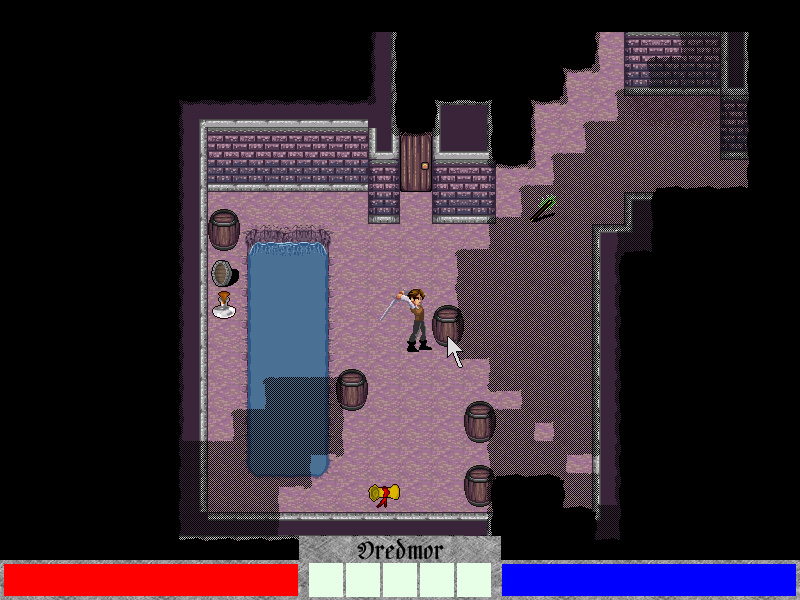
Dungeons of Dredmor as I met it in 2008-2009, before any of my art was added to the game.
Nicholas' father had decided to sell his house at some point in 2009 so we had to clear out that basement office. (I made off with one of those government-surplus chairs.) With no office we would hold sporadic "design meetings" at Nicholas' apartment. When I moved to Vancouver in fall of 2009 this became more difficult, but we kept it up. I'd take the ferry over, we'd do our meeting and maybe share some scotch, then oftentimes I'd crash on Nicholas' couch before catching the ferry back the next morning. I recall at least one case where I found myself hungover and running toward Blanchard street in downtown Victoria to catch the bus to the ferry terminal. Ah, the things we can do to ourselves in our 20's.
For a while, particularly after a planning session, we'd be excited and get more work done. For a while, if everything was quiet or there was disagreement on some feature or some other aspect of life intruded, it'd start to drift.
Most of the underlying features of Dungeons of Dredmor came together conceptually in this time, though the real grinding work of finishing and polishing would come in the later period of 2010-2011, eventually filled with ill-advised workdays running from 5pm to 5am as Nicholas and I worked together on features, trading IMs and checking off spreadsheet tables remotely.
It's incredible how many key elements of the game solidified so late in development - the final stats system, the skill trees, the non-boring magic system. I'll talk about some of those. But it was that deep polish pass in perhaps the last 6-12 months of development that really took the game from a functioning video-game for the home computer to an experience in which every action could result in delight. You know, that extra little thing that made Dredmor special.
* * *
Let me start up with those design anecdotes.
A Numberless Game?
In the original design of Dredmor, Nicholas intended to have no displayed numbers. This was, of course, insane.
His original thought, I think, was a compelling aesthetic impulse that could have worked in some other game. Charitably, the idea was to keep the player in the headspace of the fantasy world of the game experience rather than thinking about it as some kind of spreadsheet optimization exercise.
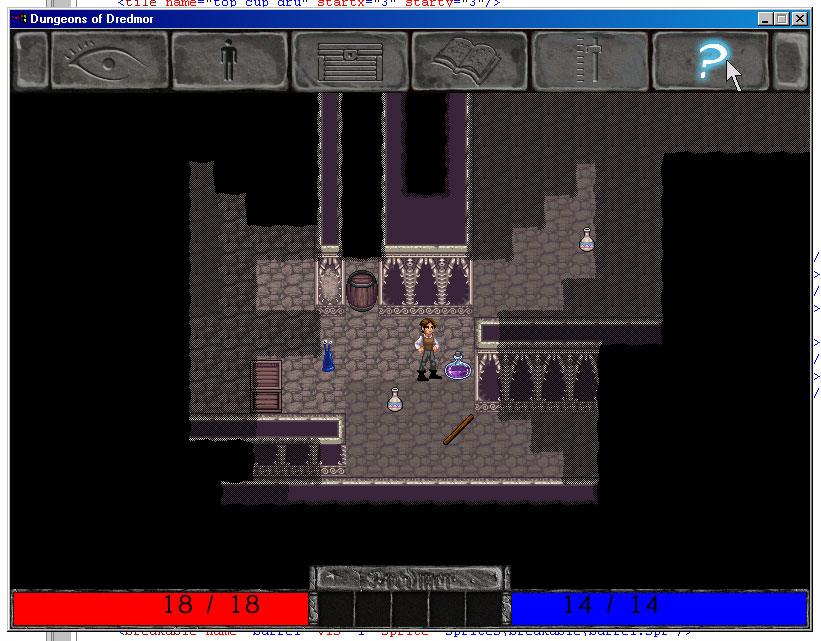
Another shot from before I was involved. Here we see the Sierra-style UI and the original Crypts tileset - I stuck fairly close to that design in the final, now that I see it again. No, I'm not sure what's going on with the stone texture treatment.
I mean, it's a noble cause. And some people actually love spreadsheet games.
But. Driving the entire monster combat experience, essentially the entire game, through pure aesthetics could not work with the small and fixed animation set we had to work with. There was exactly one 'get hurt' animation per character, one attack each for the player with a handful of weapon types (kick, mace, sword, axe, staff, dagger, cast) - yes, this is why kicking and not punching is an attack style in Dredmor.
(Notably, there were a large variety of different death animations, especially for the player character. These we made special efforts to support to satiate our sadistic impulses toward the player.)
Is an attack strong or weak? Did you get hit for a lot or a little? Is what you're doing effective in any way? If we don't display numbers on the screen, there is no way to determine this information. Or say we do use the animations: then there are only three result states of an attack you can visualize: it hits, it doesn't hit, or it kills the enemy. A game can be built around "it hits" being enough nuance for a combat system, but for a roguelike with items, armor, skills, resistances, and so forth the fun is in how all those details add up.
Nicholas relented and agreed to try out floaty little numbers. It felt great to play, and that was the end of that question.
The animation limitations also led to implementing unique sounds per damage type and the addition of those little visual sign-boards for special combat effects like "dodge", "block", "counter", "critical hit", and "haywire".
The point of all of this is if you can't show, then make do with tell.
The next design insight is theft.
Steal from Diablo
Whenever I came to a visual design problem in Dredmor, my first impulse was to look to the game Diablo (1997) but mostly Diablo 2 (2000). They'd come up with answers to every design problem we would face with inventory, combat, spellcasting UI; everything. They had more people and more money to solve those problems, they came up with good solutions, so our starting place should be whatever they did.
Better yet, Diablo 2 was a fantastically polished game. Everything you do in the game feels good: hitting enemies, dropping items, gaining levels. There are small sound effects to accompany every interaction, little shiny glints; just an incredible attention to detail. Any game that makes re-organizing your inventory such an animal pleasure is worth stealing from.
At least as a starting point.
Because the way this would play out is I'd look at what Diablo did, then try to build out from that idea with solutions that were actually within our capability to implement, and appropriate to our game themes. You can see this everywhere: Dredmor's primary gameplay UI, the player paperdoll, skill/spell selection screens, the sparkling on items on the floor. Well, the inventory bag was definitely stolen from Ultima, but it did receive a Diablo-style inventory grid!)
Diablo 2 is everywhere in Dungeons of Dredmor.
Want to play a game? Drink every time Diablo comes up. (Or don't, please. No human body can handle that much mana.)
Let's talk through an example of adapting a Diablo design to Dredmor.
Skill Lines
In proto-Dredmor, there were no non-magic active-use abilities. Swordsmanship made your sword attacks better. (Which you'd know if you could see the numbers, I suppose. And you couldn't). Armour skills made your defense better, maybe. It was rather unsatisfying.
Spells weren't in a great state either, to start. Much like Diablo 1 and certain roguelikes, magical spell discovery was item-driven. You'd find a scroll or book in the dungeon, read it - consuming the item - then have a chance to discover a random spell. This was fickle and frustrating.
What if we make everything more like Diablo 2?
When you level, you get skill points which you can spend to open up new skills. These should have cool icons, make sounds when clicked, and, ideally, grant interesting spell-like abilities whether magical or not. This means that a warrior might have some kind of sword attack that hits 3 squares in front of them - this uses some code originally written for area-attack spells. Give that ability a turn-based cooldown then suddenly the warrior has interesting choices to make while playing the game rather than only "attack" or "don't attack".
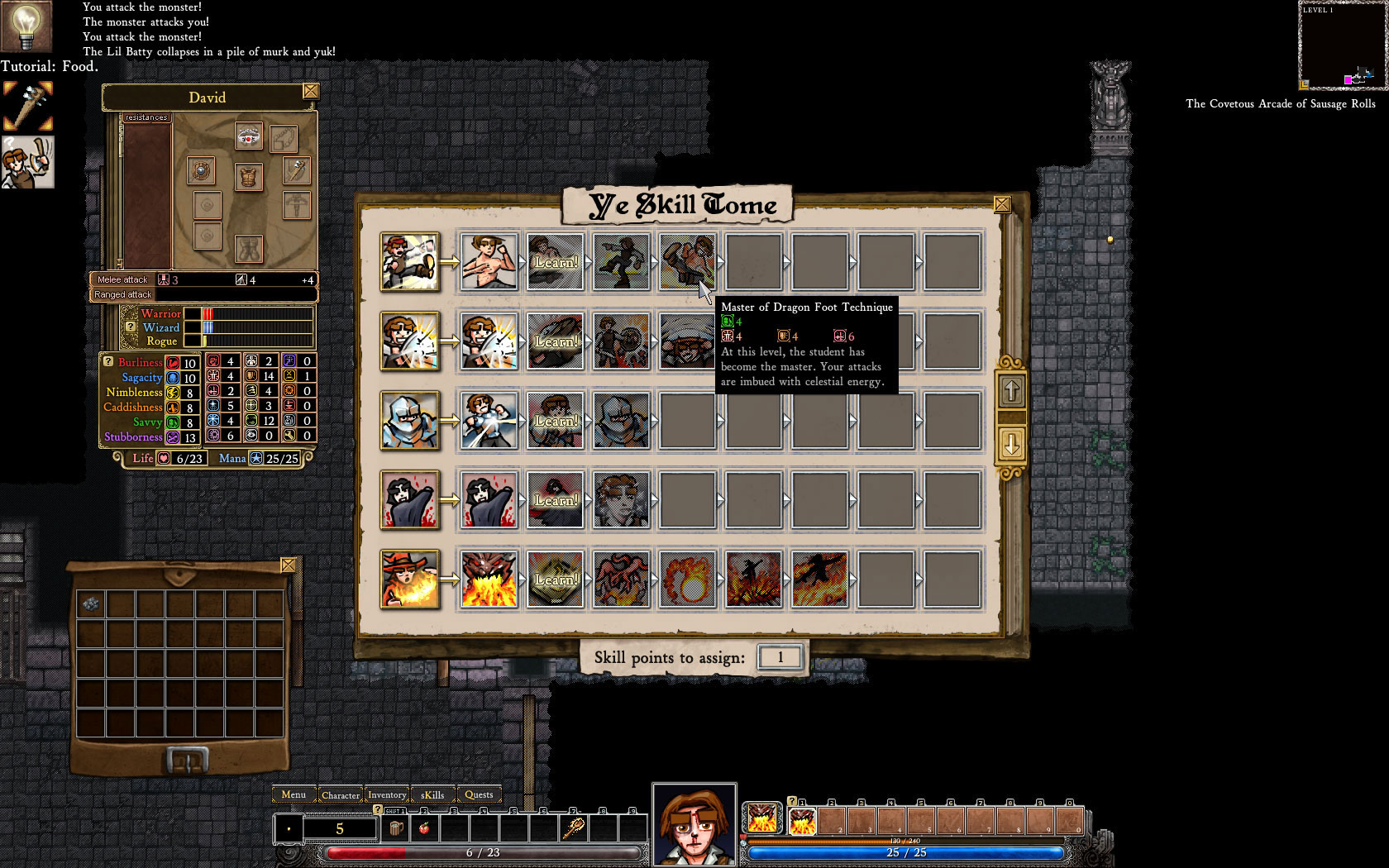
An early iteration of the skill-lines, before all skills were expanded to eight entries.
When a player starts a game of Dungeons of Dredmor, the first thing they do is select seven skills from a list. You make your own character class, basically - or select the random button to let the game choose for you!
Why seven? It's a good number. And, more honestly, we were obsessed with Dwarf Fortress. There you start the game with seven dwarves, each with a skill you chose. Same thing, right?
Now one thing we definitely didn't steal from Diablo 2 is their specific implementation of skill trees: the optimal play in Diablo 2 is to save all your skill points until you hit level 30 then dump them all into the top skills only. Frustratingly, the game invalidates most of its own content because as we all know via the wisdom of Soren Johnson, players will optimize the fun out of their game.
But a skill line, ah: you've only got one direction to go, from beginning to end. And because you have seven skill lines, the question becomes which do you want to have first? There's never a wasted choice, because even if you don't like the ability granted (and we always tried to make it at least a little interesting), you'd gain the statistic bonuses for another level in the class archetype for that skill - Warrior, Rogue, or Mage - with appropriate boost to character effectiveness via stat increases.

From an old planning spreadsheet, here's a skill-line that wasn't so much cut as never implemented at all.
Non-boring Character Stats
I'm repeating a story that I told on the development blog but it's too good to pass up.
For a long time, Dredmor's character statistics were the usual set in RPGs: strength, intelligence, dexterity, etc. Over-boiled D&D regurgitate, in other words. The relationship between the skills, stats, and combat results was also a bit of an over-complex mess which made it impossible for a player to intuit what adding (for example) one point of strength to their character would result in. More melee damage, maybe? Hit points? How much? Who knows.
One day while doing freelance work I listened to a podcast which discussed the design of role-playing games. The insight that I locked onto was this: the stats in your roleplaying game should be what your game is about. Is your game about hope? Make it a stat. Is it about fear? Make that a stat. This makes the theme of the game into the mechanics of the game.
(The inverse is also true: whatever stats are in your game, the game will become about that, so be mindful.)
What is Dredmor about? Is it about being strong, intelligent, and wise?
No! You're some weirdo who ended up in a terrible situation, probably by mistake, or being tricked by an unscrupulous monarch. The players qualities should reflect a certain... unheroicness.
So I came up with backhandedly "heroic" statistic names, associated themes, and figured out how they'd all work together and fit into character-class archetypes:
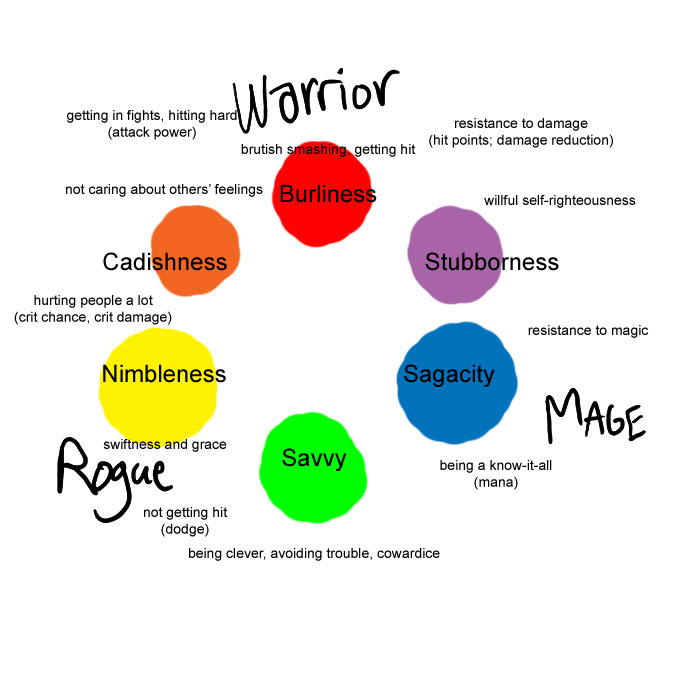
Alongside this overhaul of the skill aesthetics, I proposed a simplification of the entire stats system. We'll dig more into that in a moment, but basically the numbers were made lower and had more direct relationships with the secondary statistics which were used by game mechanics.
I sent this over to Nicholas, who recognized it as the obviously correct approach for this sort of thing, and he got it running in the game within days.
That's the story I told on the blog. But it wasn't quite that simple. Where'd this all come from?
Too many numbers
I was not involved in the compiled code side of Dredmor's development. It was in C, maybe? And early on, I had no idea how the combat calculations worked, and wasn't particularly involved in the development of that entire side of the game. At some point Daniel began working on a massive overhaul to whatever Dredmor was doing before. He had some kind of equation that produced an ideal damage output range per skill (or dungeon?) level, and was working out the game mechanics to produce this output - or something to that effect. It wasn't finished, and from what I could see, it felt like a mess.
The other thing Daniel wasn't done with was the final semester of his university degree, so while this system sat half-baked, he had to significantly reduce his time on Dredmor for a few weeks, maybe longer.
So, we had a bit of a problem: the combat was bad.
Let me soften the blow of this story with a compliment: What I admire most about how Daniel works is his dedication to the scientific method. Whether it comes to modelling game data, management, or mechanics, Daniel will do his research, perform an experiment, gather data, and evaluate the results. Then, with passion for the process but without undue emotional investment in being right or wrong (something Nicholas and I are not quite capable of, each in our own ways) he would revise and iterate his approach from there.
In this case, he had decided to deploy some of the mathematics he learned during his degree program to calculate ideal attack damage in an extraordinarily complex way. And the implementation wasn't complete. You might see output values of -300 after one swing of the sword, and 12000 the next.
Bugs aside, numbers with this kind of range are impossible for a human to intuit at a glance. If a player knew their character stats, their weapon stats, and the enemy stats, there was no way to grasp how the relation between them would result in the number the game gave you after combat. There were also serious UI design problems, which didn't help players understand any part of this anyway.
So like I said, this isn't working.
Here's a new idea: We should try to keep all numbers within a scale of 1-10 or 1-100. Those are easy numbers to understand. We should have no random weapon damage ranges, because they add nothing to the game; the result of your melee attack should derive from the consequences of your decisions up to that point, not a random number generator.
And, eventually, that's what we did: item stats were set in the range of a 1-10 scale, more or less, and total player stats were set in the range of 1-100, more or less. The expansion packs and certain magical items created a lot of inflation by the third expansion, but the rule was to keep numbers as low and simple as possible.
Here's what passed for a combat calculation design document at the time.
This worked out pretty well.
Too bad I made all the stat icons at an eye-strain-inducing 14x14 pixels.
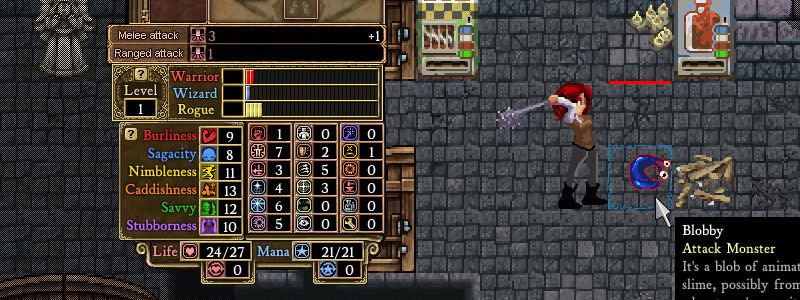
This isn't as helpful a layout as I thought it was at the time.
Why this didn't work out pretty well
Now the problem with this is that Nicholas and I did this without talking to Daniel. At all. He was admittedly busy with what was probably the final semester or so of his degree, but we cut him out of the process and he felt like his contributions could be tossed without a chance for him to even finish implementing and testing them.
It wasn't that we chose the wrong design - it's that we were extremely inconsiderate in how we chose the right design.
There came a point where he said, basically: Okay, you guys do your thing. I need to finish my degree. Tell me when you have a game ready to sell and I will help you sell it.
So he did. And we did.
(Though actually we told him we were "ready to sell" probably about a year before we actually did sell anything, so there's another lapse of judgment. At least it brought Daniel back into active development.)
If I recall correctly, Nicholas and I did believe we could probably finish the game with just the two of us working on it. But I know that I for sure didn't think we could ship it without Daniel - between the three of us, he was the most able to talk to normal human beings like a normal human being. Nicholas is prone to manic excess, and I to withdrawn introversion. I wouldn't trust us to run a business at that point if I weren't me.
Not using basic communication and teamwork skills almost tanked the project. If Daniel hadn't forgiven us for this, or at least decided that he could live with it, that'd be it.
* * *
This certainly wasn't the only such incident. And the recipient of this behaviour was any one of us at one point or another.
There's more to making a game than art, code, and business. Management, leadership, communication, teamwork, not being a thoughtless jackass; these are all real, essential skills that can be improved with intent and practice.
And we were all 20-whatever and bad at this stuff. I have to imagine more mature studios would have a lead pull a cocky 20-something aside and explain to them that it's not enough to be "smart" or "right"; you have to actually work with other human beings. Maybe that would have benefitted us.
(Then again, the games industry grinds through its young so quickly that it's rare indeed for anyone to last very long. And even worse, those who do often buy into the toxic management practices that they were subject to.)
It wasn't all bad like that, though. Let's look on the brighter side of this collaboration.
Riff Sessions
When I described those design meetings earlier, maybe I should have called them "riff sessions". One or another person would propose a silly idea as a solution to a design problem, "It'd be funny if...", then the others would start to riff off that, refine the joke, make it funnier.
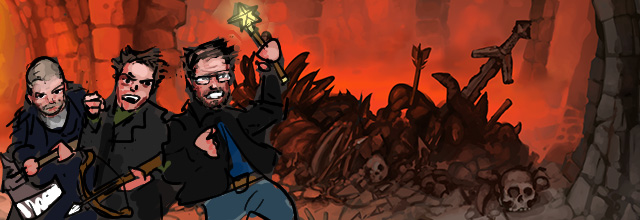
All the viking and lutefisk stuff came from Daniel, who actually lived in Norway for a while.
Nicholas was obsessed with Britishness, so if there's any extremely British nonsense in Dredmor, that's probably him. Though all of us, as men of culture, were familiar with the works of Monty Python. Nicholas is probably at fault for any of the strange anime references as well, it all means nothing to me unless it's Akira or Miyazaki.
Much of the content came out of the general zeitgeist of the internet and gaming culture at the time as well. I wouldn't say that "meme culture" as it's now known had developed as-such, but there were the beginnings of it then. We also all thought Penny Arcade was a hoot then, and I think Nicholas and I shared Jerry Holkins' appreciation for the works of H. P. Lovecraft and associated mythos which came through in certain undercurrents of Dredmor (and definitely in Clockwork Empires).
Anyway, take some nerdy 20-something dudes and stick them in a room with too much caffeine. We joked around a lot about our interests, we put that into the game, because what else were we going to do? There wasn't much of a filter to the process. We sure didn't expect any of this to be seen by hundreds of thousands of people.
* * *
What's simply amazing given the conditions is that these jokes weren't more terrible than they turned out to be. And that whatever made them funny to us could translate into a game appreciated by the general public. This doesn't work almost always. Somehow it did here.
Not all of it holds up, in retrospect.
Of note, I think the entire concept of the "Thrusty" monster being about, essentially, sexual assault is extremely cringe-worthy and I regret putting anything even remotely like that in the game. We couldn't remove it completely without blowing up savegames, but we did secretly release a patch to play down the animations and a few other excesses in 2013 or so.
I won't belabour the point, but humor that punches down isn't funny; it's cruel.
Besides that, because this was a game made in the early 2010's so there is a Portal cake reference. I apologize.
"It turns out he can write"
It became rapidly clear that putting as much game data as possible into plaintext XML files which could be edited by anyone would mean that we didn't have to pester Nicholas to make annoying little changes all the time - a major motivator.
I can't stress how useful it was to open up aspects of the game design. Not only would Nicholas get bothered less, but everyone gets the ability to take on some of the work, and then everything got iterated more rapidly and became better, faster. Everyone wins.
(This strategy turned out to be what made the best parts of Clockwork Empires work as well as they did, too. And the inverse: those parts of the game that weren't made accessible to all of the development team ended up working the most poorly because they received the least iteration.)

A few items from Dredmor.
As I drew new item sprites, I'd drop them into the XML file. There had a description field, so I filled that in. Gotta amuse myself somehow while grinding through all these sprites.
"Hey, these are funny," I paraphrase Nicholas saying. And from then on, I wrote more and more of the game content.
And you know, I never did receive proper credit for the sheer quantity of writing I did for Dungeons of Dredmor - or Clockwork Empires, for that matter. Even in press quotes, my words would be attributed to the louder Gaslamp partners more than a few times. (It's okay Evan, I forgive you.)
* * *
It's difficult to express exactly, but there's a certain way that words in a sentence can feel correct. If they're words forming a joke, it's even more important to get the flow and feel of those words just right because that's the delivery. Just like a verbal joke, the delivery of a text joke can make or break the punchline.
As time went on, the role fell more and more to me to do final-pass editing on blog posts, public-facing statements, and even marketing as I coordinated production of the video trailer for the first expansion and every trailer afterward.
* * *
I regret that I did not stand up for myself more with all of this. My attitude was that if I put my head down and did good work, people would notice. This is true to a degree, but it's a heck of a lot easier to get noticed when you actually talk about what you've done and insist upon taking credit for it. Especially when you're standing next to people who are inclined to be very much louder than yourself.
So, better late than never: During the course of Gaslamp games, my voice was generally subsumed into the collective "Gaslamp we". "We" wrote this, or designed that. Never I.
But I did write that; most of it, even. I get to say that because I'm now the one writing this. So there!
(I feel a little better, thanks.)
Let's get back to game development.
The limits of procedural generation
As noted, we were fairly obsessed with Dwarf Fortress and the whole idea of procedural generation. The problem with procgen, of course, is that it can suck. Randomness without meaning is noise; it's boring and meaningless. You can squint a little at an image of random noise and you'll soon realize that what you're looking at is a flat mid-gray.
The trick is to randomly generate content in a way which suggests meaning. This is not simple.
* * *
Dredmor's dungeons were originally completely procedurally generated. And indeed they were also rather boring because although they were random there was only an exceedingly small chance that their arrangements would result in interesting gameplay. A wide room with a potion at one end, a couple monsters in the middle, and a trap in some corner you have no reason to investigate - it's just fluff.
But what if you had a trap that shot down a long hallway, and there were monsters - or treasures! - in niches along that hallway? That's an interesting situation which engages with game mechanics and even a sort of narrative. What if a room's floor was completely covered in gold? Interesting.
These were effectively impossible results in the original procgen system. Theoretically, one could keep working on the generation algorithm, maybe some kind of theme system and a bunch of sub-algorithms which could... take forever to program, and we needed Nicholas to be doing feature development like implementing new spells, fixing savegame bugs, and figuring out how we're going to make this game work at higher resolutions than 800x600.
I suggested that we should predefine rooms, maybe with some kind of editor, then sprinkle those into the game. (Diablo does this! - drink.) Daniel and I cooked up an XML scheme then I think Daniel convinced Nicholas that there was an interesting math problem in the feature request due to the requirement to connect room doors to other room doors without the rooms overlapping. This pushed Nicholas over the line to where he was willing to give it a try.

And once this was in the game, it felt great.
I even made myself a little Python program to convert tiny sprites into room code, so I could draw rooms to dump into the XML. The more rooms were added, the better the game felt. I could push the limits of the room features, make jokes, make devious traps with suitable rewards.
Over the course of the expansions, we only added more features for rooms: scripted text, removable walls, extravagant decor sprites, timed triggers, arbitrary spell triggers. This was a great feature.
Momentum
The Momentum mechanic was a design push largely sustained by Daniel, I believe, in those early days of one of his combat mechanics overhauls.
The idea was this: hit an enemy in melee combat. That adds 1 to the Momentum counter. For every certain number of turns you don't hit an enemy, your momentum counter goes down. The more momentum you have, the more damage you do. Possibly you can pull off special moves by spending momentum?
The idea feels like something out of Magic: The Gathering, or a tabletop roleplaying game. It's simple, the numbers in play are something a person can keep in their head. And what's great about it is that the player is motivated to take risks - engaging in prolonged, continuous melee combat, and the mechanic self-caps because there are only so many enemies in an area (Monster Zoos excepted), and if you kill enemies too fast using accumulated Momentum, you will begin to lose Momentum.
It never quite worked, however. The implementation was caught up in the old, complex stats system, so it was never very clear what was going on. We hadn't even really sorted out combat turn resolution order or even basic UI issues. It was incomprehensible. The feature got set aside.
* * *
Dredmor eventually received generic spell/skill mechanics and UI features - all scriptable via XML - which enabled a "Combat Momentum" system to be implemented in the mace weapon skill-line. And we did so probably over a year after that initially flailing around with a hardcoded take. All that work was not for nothing, it turns out.
An icon worksheet for the warrior skills.
Voice Acting
I specifically remember we were at Nicholas' apartment for a riff session, and a certain humorous edit of the trailer for the movie 300 came up and... it ended with Daniel shouting/growling in his most manly voice into a truly awful laptop microphone: THIS. IS. CAKETOWN
We put it in the game.
It's a tremendously stupid joke - that we stole, mind you - but... no, this one is largely indefensible. I wrote a whole thing about humour in Dungeons of Dredmor and how I tried to avoid any "joke" that was based solely on making a reference to another thing, but I feel like this might break the rule. I suppose what's funny about it is the sheer stupidity of adding a context-breaking event to the game, a voice line played when an object is picked up, that appears nowhere else. It suggests a willingness to break the self-set consistency of the game world, and for what? For that? Really?
Yeah! (That's the magic of Dredmor! There are quite a few examples of context-breaking joke features.)
* * *
I'm not quite sure how The Announcer ("Your inventory is full!", "You need more mana, drink more booze!") came up, but it is absolutely a riff on Unreal (1998)'s "Monster Kill", etc lines. Because what's more badass than a cool announcer in our definitely-badass game, Dungeons of Dredmor? The appropriation of macho FPS aesthetics is all over, from the little reactive Doom-face in the game UI to the title screen and elsewhere.
(That little face in the UI was such a great feature to steal. Surely someone's written about how much life that little face adds to the game, peering left and right, grinning when you find a new weapon, dying when you died. iD rather dropped the ball in Quake when they didn't add those extra little animations.)
What really makes The Announcer all the more amusing to me is that sound & music guy - and Dredmor announcer - Matthew Steele is such a soft spoken and gentle person in real life.
What's with the cheese?
I was showing my (new, in Vancouver) partner the work I was doing on Dredmor.
"Is there cheese?" she asked.
"Yeah, we have a cheese," I said.
"But what if there was more?"
"I don't know anything about cheese, what kind of cheese should I draw?"
She started listing off cheeses she thought sounded delicious and that's how I ended up drawing so many different cheeses for the game.

Possibly the least delicious-looking cheese in the game.
A linear story for Dredmor?
There's an interesting what-if here.
I remember thinking that it'd be nice to include more narrative elements in Dredmor. Like all of my best ideas for the game, the plan would be to rip off Diablo (drink) and create situations involving mini-bosses, perhaps with unique text and items, possibly requiring the boss to be defeated before proceeding in the dungeon.
The best developed of these involved some kind of boss carrot monster that lived in a garden patch, and... I quickly realized that this was biting off more than we could chew given our feature-set, and our consensus was more or less that the fiction of the game didn't support linear narrative elements very well. This design choice was made *very* early in development, mind you; I think by the time we got into the later expansions... well, it didn't happen.
Would you like the read extensive notes for a never-implemented narrative in Dungeons of Dredmor?
- Here's a take on narrative interactions, quite short.
- Here's another, starting to think about how to integrate story with locations.
- Here's a fairly long narrative treatment for Dungeons of Dredmor. (This is pretty good.)
The game worked pretty well with bizarre situations appearing based on random association and/or procedural generation. The player could then project their own meaning onto these random elements, and it'd end up a new experience each time. Was it funnier than anything we could cook up for a narrative?
Maybe.
Was I confident about my ability to write and implement a story in a game?
Absolutely not.
(As mentioned, we were all rather obsessed with Dwarf Fortress and the holy grail of procedurally generated everything. I think most game developers were for a while there; DF was such strange artifact, a piece of outsider art from nowhere that made everything think of the possibilities of procgen in entirely new ways. We were enthralled.)
That carrot boss monster never got further than a rough sketch. Related:
Why is there a kitten?
My plan for the Kitten sprite was that it'd be an item required to defeat the final boss of Dredmor, the lich Dredmor himself.
Again, ripping off Diablo (drink), a kitten was a vessel pure of heart (sure) which could contain Dredmor's evil. The Hero would have to kill Dredmor, contain his soul in the kitten... then shove the kitten into his forehead, just like in the ending video for Diablo.
Then for Dredmor 2 you'd have to fight the previous Hero with an evil kitten in his forehead.
I thought this was extremely funny at the time, I was actually rolling on the floor of Nicholas' apartment laughing about it.
* * *
So no, we didn't do that.
Anyway, that's enough faffing about. Let's find out how this silly thing actually made any money.
How to succeed on Steam
Now, how do we get onto Steam, the one and only online distribution service that matters in the years 2010-2011?
It just so happens that Daniel's girlfriend's sister's fiance, Chris, was in a business development position at some kind of mobile games company or something like that. Daniel was talking to Chris at some family get-together about what we were trying to do with Gaslamp and it came up that Chris knew someone who worked at Valve.
Boom, that's it.
Daniel had Nicholas and I meet with Chris at a pub in Victoria, we expressed some baseless fear of mobile-game style commercialism messing with our creative control and Chris told us that he had no interest in any of that (he probably had zero expectations from us and was entirely doing Daniel a favour here); we all shook hands and with that Chris became our part-time business development guy.
That's all it took. It's a ridiculously unlikely coincidence that a connection like this would come up.
What's more, the second ridiculously unlikely coincidence was that Valve Software was just then preparing to launch Steam for MacOS in 2011 - and they desperately needed MacOS titles to fill out their catalog at launch.
Did we have a MacOS title? Yes we did. Was Valve interested in talking to us about this? Yes they were. It's not like they had many options.
That's two enormous strokes of dumbass luck in a row. Without both of those, it'd never have happened. Maybe we'd have made a few grand, and likely we'd have had to go our own ways to survive.
What it all came down to was being vaguely competent right where two bolts of lightning struck at the same time.
Working with Valve
The landscape of indie games was a different world in 2011. Kickstarter didn't exist, Patreon didn't exist, Early Access wasn't even a concept. Steam Greenlight hadn't happened. Working with Valve back then has zero resemblance to whatever you do now. There was simply none of the infrastructure that exists now.
Thanks to Chris' work, we had a contact at Valve. Just like, a guy. We could send him an email or call when stuff went wrong or we wanted to do something new. That's how it worked.
There were no backend controls for our Steam page, though I do believe we were provided a way to view sales. To set up the store page for Dredmor what we did was talk to our guy and he made sure it got set up. Valve even helped put together promotional art in certain places based on material I provided. Can you imagine that now?
(Now, of course, Steam is a different beast entirely. It's impossible to talk to a human being; it's a machine honed to avoid demanding any human attention from a paid employee of Valve Software.)
Even a couple years later, I remember talking with some technical people who worked at some A and AAA-level studios; our treatment in that first year or so was better than they got not even very long after.
Of course, back then you could count the weekly game releases on one hand, probably. It got busier toward the holidays, but the scale was unimaginably small considering the raging torrent of game releases nowadays. And there there weren't seasonal sales like clockwork back then; that started in later years, once someone ran the numbers of what the Humble Bundle was doing, probably.
And now, the entire industry has warped its practices around trying to game Steam for more exposure and - well, that's irrelevant to Dungeons of Dredmor, isn't it? What's bizarre in hindsight is how working with Valve was like working with a normal business, not so unlike the team we partnered with to produce t-shirts and stickers.
So we got our game on Steam. They gave us a launch date, we did our feeble best to promote it.
(Oh, and for some reason - a third bolt of lightning strikes - the streamer Total Biscuit made a video about Dungeons of Dredmor and released it alongside our launch date. Possibly he had made a video during the beta? I don't quite remember, but: his video had a far greater effect on marketing the game than anything we managed to pull off on our own. We didn't even pay him for an endorsement or anything, nothing like that, as is standard practice for the big streamers nowadays.)
$50,000
On the first day we made 50 grand. I'd never made that much money before (minus 30% for Valve, minus another 30% for taxes, we'll assume, minus a bunch of payments owed to various people with whom poor revenue sharing deals were made in the proto-Dredmor days).
You can imagine us watching that number tick up and completely flipping out, unable to focus on anything at all.
Nicholas thought Dredmor would make a few thousand dollars. Daniel suspected even less. I think my expectations were a bit higher, but... it was mind-blowing. This meant we were real. We shipped a game. It actually made money. This changed everything.
We held a launch party in Victoria. I remember absinthe, cuban cigars, and a truly monstrous hangover.
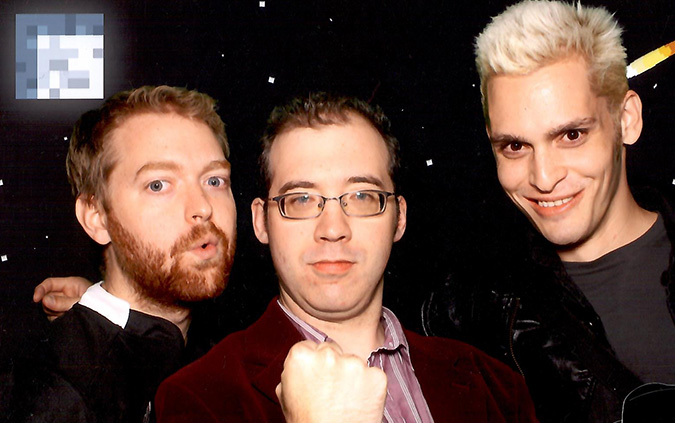
The Gaslamp Partners: Daniel, Nicholas, David. This was taken a year and a half later, at the Mojang party at PAX 2012, but it expresses the correct sentiment for the moment. I'll tell the story of that party in part 3.
It did change everything. It just took a month for Valve to get the payment out.
Why am I still poor?
In May or so I told all of my freelance clients that I was shipping Dredmor, so I needed to wrap up their work before July.
(All except for Alex Mosolov making Starfarer - now Starsector. I told him I'd stick with that game 'til we were finished. And I kept working for him throughout the entire run of Gaslamp Games, and now I do more work on Starsector than anything else. Weird how that's worked out.)
... Unfortunately, Valve only does a payout after the month of sales is completed. So despite the success of Dredmor, I had to borrow money to pay my rent that month.
(I think Alex might have paid me for a month of work ahead of time around then, which was very kind of him.)
When we actually got the money into a company account and worked out a one-time payout scheme for the three partners to make up just a little bit for the years of unpaid development time... the bank held my money for two weeks because they couldn't believe that someone like me would receive a few grand.
Man, I was pissed. Owing money, and six weeks of waiting!
Anyway, it got sorted out with time. While money does not buy happiness, it sure takes a lot of immediate stress away.
* * *
Back in Victoria, a few years previous, I remember walking and having a conversation with Nate, the original connection who got me into this whole mess through a Livejournal connection. The topic of work came up, and the purpose of it all.
Specifically, if we had somehow got paid $500 more a month, what would we do with it?
His answer was "work less" (which I respect more and more now). Mine was "buy food". Fresh avocados, limes, fancy herbs and spices, real juice. I was mostly living off cheap bulk foods then; lots of lentils, rice, flour, potatoes, chickpeas
Suddenly, I wasn't poor.
I wasn't rich, either, not by a long shot. But I was employed and paid as if I had a normal, regular, stable job.
As the bearer of a fine arts degree, this was a shocking development and I felt tremendously wealthy. Imagine: buying new clothing. Going grocery shopping and not tracking the total cost in your head. Going to a restaurant and having a drink without worrying. Before too long, I moved with my partner into a nice rented condo in a building built after the year I was born. Life was good. All that deprivation was not for nothing.
I'd succeeded.
Part 3a: "The Indie Golden Years"
Return to blog index